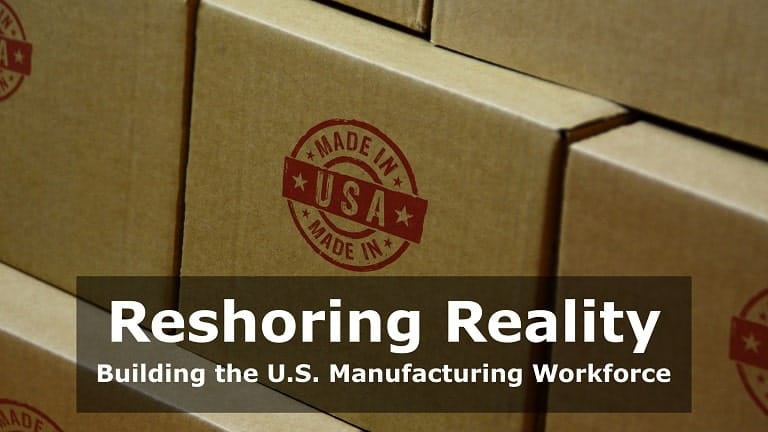America is undergoing a manufacturing revival. After decades of offshoring, companies across industries are bringing production back to U.S. soil—a movement known as reshoring. Driven by supply chain disruptions, global uncertainty, and a renewed focus on quality and control, reshoring is no longer just a trend; it’s a strategic imperative. But as businesses move to localize their operations, they’re running headfirst into a new kind of challenge: a critical shortage of skilled domestic manufacturing talent.
Years of outsourcing have eroded the workforce infrastructure needed to support high-quality, high-volume production at home. The result? Companies eager to reshore are finding themselves slowed down—not by equipment or capital—but by the inability to find qualified workers. From machine operators and quality inspectors to automation specialists and engineers, the talent gap is becoming one of the biggest barriers to reshoring success.
This article explores the reshoring manufacturing talent crisis—and more importantly, what can be done about it. We’ll break down why reshoring is surging now, examine the root causes of the talent shortage, and provide a clear, strategic roadmap for building a world-class manufacturing team from scratch. Whether you’re a growing company navigating your first reshoring project or a large manufacturer scaling up domestic production, one thing is clear: you need the right people in place—and fast.
With the help of expert partners like JRG, building that team isn’t just possible—it’s a powerful competitive advantage.
The Reshoring Revolution: Why It’s Happening Now

After decades of offshoring production to countries with cheaper labor, the U.S. is experiencing a powerful shift: a reshoring revolution. The COVID-19 pandemic, geopolitical tensions, and supply chain disruptions have exposed the vulnerabilities of over-reliance on global manufacturing networks. As a result, more American companies are rethinking their production strategies and bringing operations back home to reduce risk and regain control.
One of the major catalysts for reshoring is the increasing uncertainty in global supply chains. From port congestion to raw material shortages, manufacturers have faced significant delays and cost overruns. The realization that a single disruption in another country can stall domestic operations has made localization a strategic priority. By reshoring, companies gain better control over logistics, reduce lead times, and enhance their ability to respond to market demand swiftly.
Geopolitical tensions—especially those involving China—have also driven U.S. companies to reconsider their dependence on overseas manufacturing. Tariffs, export restrictions, and shifting trade agreements are making offshore production less predictable and more expensive. In response, federal and state governments are stepping in with policy incentives. Tax breaks, grants, and funding for advanced manufacturing initiatives are making reshoring not just a strategic move, but also a financially sound one.
The numbers speak for themselves. According to the Reshoring Initiative, U.S. companies announced over 360,000 new reshored jobs in 2023 alone—the highest annual total to date. Sectors like electronics, pharmaceuticals, and heavy machinery are leading the charge. What once was seen as a cost-saving maneuver—offshoring—is now being reevaluated in favor of resilience, speed, and national security.
In today’s unpredictable global climate, reshoring is no longer a trend—it’s a transformation. However, while the shift to domestic production is accelerating, a critical roadblock remains: the lack of skilled talent at home. Solving this talent challenge is essential to reshoring’s success—and that begins with a bold, proactive strategy for rebuilding the workforce.
The Talent Crisis in U.S. Manufacturing

As U.S. companies race to bring manufacturing back home, a daunting obstacle stands in the way: a domestic talent crisis.
While reshoring promises greater control and resilience, the ability to execute this vision hinges on one critical factor — workforce readiness.
Unfortunately, the current state of the U.S. manufacturing talent pool reveals a deep and urgent skills gap that threatens to derail these efforts.
Why the Talent Pool Has Eroded
Decades of offshoring quietly chipped away at America’s industrial workforce. As jobs moved overseas, domestic investments in:
Training programs
Apprenticeships
Vocational education
began to decline.
Manufacturing lost its appeal as a career path. Younger generations turned instead to sectors like tech, healthcare, and finance. The result? A pipeline that’s been drying up for years.
An Aging Workforce with Few Replacements
The problem is not just the shrinking number of workers — it’s also who’s left in the workforce.
Today, many skilled professionals in manufacturing are nearing retirement. Unfortunately, there aren’t enough trained workers entering the field to replace them.
Impacts of the aging workforce:
Loss of institutional knowledge
Increased labor costs due to overtime and retention
Burnout among existing staff
Delays in scaling production
It’s Not Just a Numbers Game — It’s a Skills Crisis
Modern manufacturing requires a far more advanced skill set than in decades past. Today’s production lines need workers trained in:
Robotics and automation
Precision machining
Quality assurance
Supply chain software
Yet, many candidates lack even the foundational skills to step into these roles.
According to the National Association of Manufacturers (NAM), nearly 2.1 million jobs could go unfilled by 2030 due to the skills gap alone.
Why This Matters for Reshoring
Without the right people in place, reshoring plans can’t get off the ground. Companies face:
Longer ramp-up times
Missed delivery windows
Project delays
Lower output and reduced customer satisfaction
It’s not just about hiring—it’s about building the right team.
And most companies can’t do that alone.
Expert Partnerships Are Essential
Tackling this talent crisis requires a proactive, strategic approach. This is where expert firms like JRG come in. They specialize in identifying, attracting, and placing top-tier manufacturing professionals at speed.
Partnering with JRG helps manufacturers:
Cut hiring timelines
Improve candidate quality
Reduce onboarding friction
Scale operations faster
If reshoring is the destination, building a strong domestic team is the engine—and JRG knows how to fuel it.
The Strategy: How to Rebuild a Domestic Manufacturing Dream Team

Reshoring manufacturing to the U.S. is only half the equation. The other half—and arguably the most critical—is building the skilled team to power it. Here’s a step-by-step strategy for assembling a high-performing domestic manufacturing workforce from the ground up.
A. Define Your Talent Blueprint
Before hiring begins, manufacturers must clearly define the roles, skills, and capabilities needed to meet their production goals today—and tomorrow.
Identify Current and Future Skill Needs:
Modern manufacturing requires more than manual labor. Skills in CNC machining, mechatronics, quality assurance, robotics, and supply chain tech are now essential. Audit existing capabilities and match them to future innovation needs.Align Talent Goals with Long-Term Strategy:
Hiring should support broader business objectives, including digital transformation, lean production, and sustainability. Define the roles critical to scaling operations efficiently and competitively.Build Role-Specific Profiles:
Go beyond job titles—detail the behaviors, values, and technical proficiency each role demands to help recruiters and hiring partners target the right candidates.
B. Partner with a Specialized Talent Firm (Like JRG)
Traditional hiring channels—job boards, internal recruiters—are often too slow or too narrow to support reshoring at scale.
Why Traditional Hiring Falls Short:
The manufacturing talent gap is not just a volume issue, but a fit issue. General recruiters may not understand the nuances of technical roles or have access to niche networks.How Expert Firms Add Value:
Firms like JRG specialize in sourcing hard-to-find manufacturing talent quickly. Their established pipelines, national reach, and sector expertise allow them to identify and place candidates faster and more accurately.Real-World Impact:
“We were struggling for six months to find qualified line leads. JRG filled all roles in under 30 days—complete game changer.” — VP of Operations, Midwest Auto Supplier (hypothetical quote)
C. Tap into Hidden Talent Pools
To close the talent gap, companies must widen their lens and embrace unconventional but high-potential sources of talent.
Engage Underutilized Workforce Segments:
Veterans with logistics and mechanical experience
Graduates from trade and vocational schools
Second-chance hiring programs (formerly incarcerated individuals)
Stay-at-home parents re-entering the workforce
Commit to Inclusive Hiring Practices:
Building diversity isn’t just the right thing to do—it’s good for business. Inclusive teams bring resilience, innovation, and higher retention rates.Upskill and Cross-Train:
Don’t just hire for what someone has done—hire for what they can do with the right training.
D. Rebuild the Pipeline: Training, Apprenticeships, and Retention
A long-term reshoring strategy requires a steady flow of capable workers. Companies must proactively rebuild the manufacturing talent pipeline.
Partner with Local Institutions:
Collaborate with technical colleges, high schools, and community programs to promote manufacturing careers and create tailored training programs.Launch Apprenticeship & Internship Programs:
Provide hands-on training opportunities that combine classroom learning with real-world application. Apprenticeships create loyalty and build skills from the ground up.Invest in Ongoing Learning:
Offer current employees access to certifications, mentorships, and advancement paths. Retention improves when workers see growth opportunities.Create a Culture of Excellence:
Competitive wages, recognition programs, and safe work environments foster pride and loyalty in the workforce—keys to long-term success.
Case for Action: Why Waiting Isn’t an Option
The momentum behind reshoring is real—but it’s not without urgency. For manufacturing leaders, the question is no longer if reshoring should happen, but how fast they can make it happen. Delaying the talent-building process can result in more than just missed deadlines; it can lead to significant competitive disadvantage in an increasingly fast-moving industrial landscape.
The cost of waiting is steep. Companies that hesitate to address the domestic talent gap face operational slowdowns, longer production timelines, and project delays that can ripple across their supply chains. This lag in execution can erode client confidence, cause missed revenue targets, and open the door for competitors—especially those who have already secured skilled labor and begun producing domestically. In industries like automotive, electronics, and pharmaceuticals where time-to-market is critical, even a short delay in operational readiness can lead to millions in lost opportunity.
Moreover, the longer organizations wait to act, the more pressure builds to revert to outsourcing. This undermines the very reason reshoring became a strategic priority—control, quality, speed, and resilience. Without a skilled team to support local production, companies risk falling back into old patterns of offshoring, exposing themselves once again to supply chain disruptions and geopolitical uncertainties.
On the flip side, organizations that take bold action now are already reaping the benefits. These early movers are establishing robust domestic operations, developing talent pipelines, and positioning themselves as employers of choice in a tightening labor market. By investing now in expert-led hiring strategies, targeted workforce development, and forward-looking partnerships with firms like JRG, they gain a decisive edge: faster time to productivity, lower recruitment costs over time, and a loyal, well-trained workforce that drives innovation.
Talent acquisition is no longer a background function—it’s a strategic differentiator. Companies that act decisively to build their teams now won’t just meet production goals—they’ll become industry leaders in the reshored economy. The window to secure top-tier domestic talent is open, but it’s closing quickly. Those who wait may find themselves scrambling for resources that proactive competitors have already claimed.
In reshoring, speed matters. The companies that act today will own tomorrow.
Conclusion: Turning the Talent Gap into a Growth Opportunity
The reshoring movement is reshaping American manufacturing—but it brings with it a stark reality: the domestic talent pool is no longer what it once was. Years of offshoring have led to a diminished pipeline of skilled workers, aging talent, and a widening skills gap. This challenge, however, also presents a rare opportunity for companies to rebuild smarter, faster, and more strategically than ever before.
By recognizing talent acquisition as a key driver of successful reshoring—not just an HR function—business leaders can transform workforce shortages into competitive advantages. Building a world-class manufacturing team requires more than posting job ads or offering sign-on bonuses. It calls for a holistic strategy that begins with clearly defining hiring needs, tapping into overlooked talent pools, investing in long-term training, and—most importantly—partnering with experts who know how to navigate the complexities of modern workforce development.
That’s where strategic hiring partners like JRG come in. With deep industry knowledge, nationwide candidate networks, and a proven ability to place specialized manufacturing talent quickly, JRG doesn’t just fill roles—they help organizations build sustainable, high-performing teams. From frontline operators to advanced robotics technicians, JRG understands what it takes to match the right talent with the right opportunity—at speed and at scale.
While the talent gap is real, it’s not insurmountable. Companies that act now can reshape their operations, elevate their workforce, and future-proof their production capabilities. Those who wait may find themselves left behind in a highly competitive and increasingly localized industrial economy.
The reshoring journey is not just about bringing production home—it’s about reinvesting in people. And in doing so, businesses can fuel innovation, strengthen communities, and create a new era of American manufacturing excellence.
Ready to build a high-performance team for your reshoring initiative? Learn how JRG Partners Manufacturing Executive Recruiters can help you hire top-tier talent faster and smarter.


